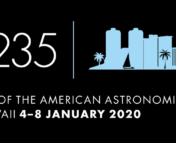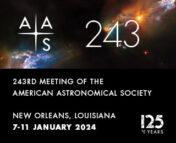Welcome to the Astrobites coverage of the 2024 April APS Meeting! We will report on highlights from each day here, from APS Plenaries to DAP (Division of Astrophysics) invited sessions to graduate student research talks. If you’d like to see more timely updates during the day, we encourage you to search the #aprilAPS hashtag on twitter. We’ll be posting once a day during the week, so be sure the visit the site often to catch all the news!
Plenary: Physics and Multi-Messenger Astronomy (by Jessie Thwaites)
The opening session of the meeting was a plenary session with three talks, covering different aspects of multi-messenger astronomy. Astronomers can use multiple signals (photons, charged particles called cosmic rays, gravitational waves, and/or neutrinos) to learn more about what is happening inside an astrophysical object in our Universe. The three speakers discussed how we can use the signals from a famous binary neutron star merger, GW170817, which was also observed in light as a gamma-ray burst, as well as a kilonova (called AT 2017gfo).
Rebecca Surman opened the session by discussing the huge amount of information we can gain by understanding the observations from kilonovae. By studying the color of the kilonova (red or blue), we can get information about which elements are present. This also helps us understand a more fundamental question – how are elements heavier than iron produced in our Universe?
The answer is through rapid neutron capture, called r-process nucleosynthesis. If the light we observe from a kilonova is red, then lanthanides are present, and these elements are hallmarks of the r-process happening to produce heavy elements. We have evidence of these elements in the AT 2017gfo kilonova. But there are still some missing pieces, such as the missing piece of the actinides, which are responsible for decaying to produce elements like gold or platinum. But with future experiments at places like the Facility for Rare Isotope Beams (FRIB), we can pin down more uncertainties on properties of these heavy elements, which will help us to understand data from this event better.
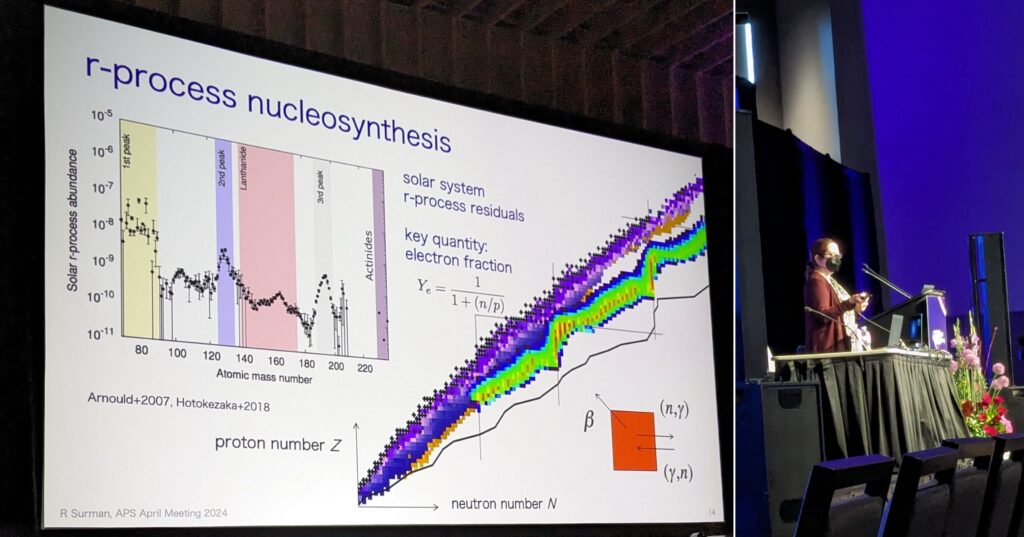
The second talk of the session was given by Nicolas Yunes, who delved into the fundamental physics of gravitational waves, by proving the extreme gravitational field near a binary neutron star merger. One such result he showed investigated the speed of gravitational waves. In the case of GW170817, the gravitational wave signal arrived 1.7 seconds before the gamma-ray burst. By using this timing information, he could derive limits on the speed of the gravitational waves from this source.
If we assume that the gravitational waves and the gamma-rays were emitted at the same time, then the speed of gravitational waves is slightly faster than the speed of light. But what if there is actually a delay between them? If the gamma-ray burst is produced 10 seconds after the merger, then the light actually catches up to the gravitational waves, making the speed of light faster. These two cases allow us to get a range for the speed of gravitational waves relative to the speed of light. These limits give a range that’s within 0.0000000000000037 (that’s 14 zeroes!) of the speed of light.
The final talk of the session was given by Hsin-Yu Chen, who discussed how we can use multi-messenger events to probe cosmic history. In cosmology, the expansion of the Universe is governed by the Hubble constant (H0). This should be a constant (in time) – but different experiments that have measured H0 in different ways don’t agree on its value. But, if we include gravitational wave information, we can measure the Hubble constant in a new way, and hopefully better understand the value of the constant.
In the gravitational wave signal, the amplitude of the wave is inversely proportional to distance (a source further away from us produces a lower amplitude signal). By using this information to calculate the distance, and using the redshift from an observed electromagnetic (EM) counterpart, we can get an independent measure of the Hubble constant. But, so far we only have one event with both gravitational waves and light (yup, it’s our friend GW170817 again), so the measurement is quite uncertain. With more events, we can get a much more precise measurement.
Cecilia Payne-Gaposchkin Doctoral Dissertation Award in Astrophysics (by Huei Sears)
The Cecilia Payne-Gaposchkin Doctoral Dissertation Award in Astrophysics is an annual award given by APS’s Division of Astrophysics (DAP) that recognizes an exceptional doctoral thesis in astrophysics. The winner is awarded $1,500 and a certificate. All finalists for this award are invited to the April APS Meeting to present their work in this invited session and are offered a $750 travel voucher. The three finalists for the 2024 award were Drs. Andrea Biscoveanu, Floor Broekgaarden, & Justin Myles.
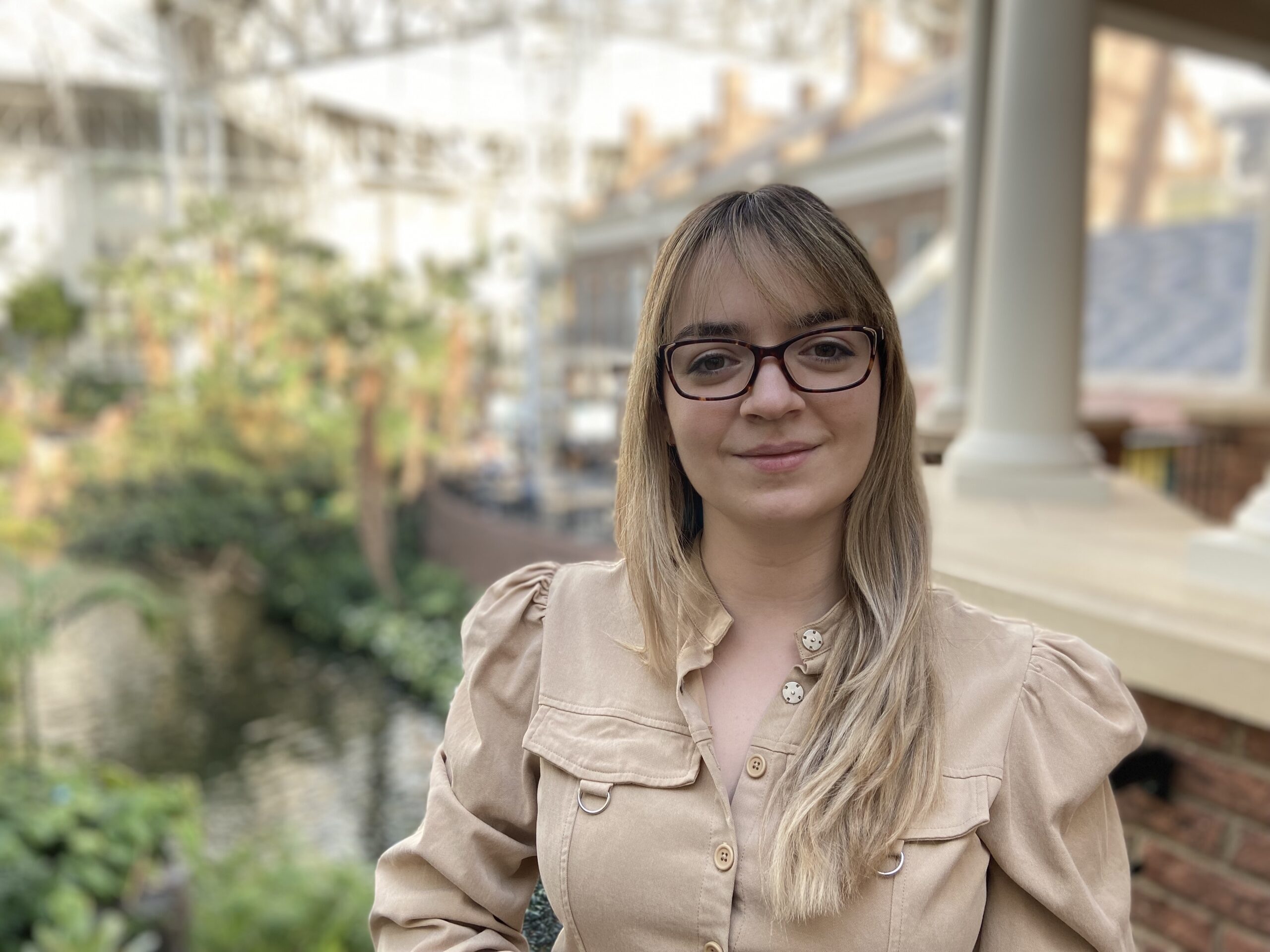
The first speaker of the session was Dr. Andrea Biscoveanu, a NASA Einstein Fellow at Northwestern University, with a talk titled “From black holes to the Big Bang: astrophysics and cosmology with gravitational waves and their electromagnetic counterparts.”
Gravitational waves (GW) were first observationally reported in 2015 with GW150914. This was the fall right after Dr. Biscoveanu had joined LIGO as a summer student, and this event was what made her know GW astronomy was her future.
There are a few things you can measure from a GW signal that are intrinsic to the compact object merger: the mass, spin, and (if there is a neutron star) the tidal deformability. Some extrinsic things you can measure are the inclination angle, the distance, sky position, and sometimes, the redshift. If there is an electromagnetic (EM) counterpart (usually only expected if the merger is between two neutron stars), you can measure some of these things from the short gamma-ray burst or kilonova too! It’s been a few years (nearly a decade!) since the first GWs were observed, and Dr. Biscoveanu says this new era of GW astronomy is about using population studies of these events to discover new astrophysics.
One of the first questions Dr. Biscoveanu worked to answer in her PhD was how we go from the “strain” of a GW signal into the true astrophysics. “Strain” is a dimensionless quantity that is used to describe the magnitude or amplitude of a GW signal. One method to do this is with “matched filtering,” where you compare templates of GW signals to the actual measurements, but this has drawbacks and in 2021, Dr. Biscoveanu showed that there was missing physics in the central bank of templates. Another method to do his is with Bayesian interference to sample across the multi (17!)-dimensional parameter space to get posterior probability distributions. This too has uncertainties, and Dr. Biscoveanu showed in 2020 that some uncertainties, like the uncertainty in detector noise, can have important effects on the systematic uncertainty of the distributions.
Using this Bayesian interference method, however, Dr. Biscoveanu was able to find that most binary black holes (BBH) have at least one spinning component. She also found that black holes were born with larger spins in the cosmic past. In studying neutron star – black hole (NSBH) binaries with this method, she found that the black holes in these mergers are less massive that those in binary black holes are likely to be more slowly spinning. Dr. Biscoveanu postulated that maybe the black holes in these NSBH mergers could evolve from different stellar progenitors. In summary, Dr. Biscoveanu has shown that when using “astrophysically-motivated” models and “innovative” data-analysis techniques in concert with GW + EM data you can learn a lot about compact object astrophysics and cosmology!
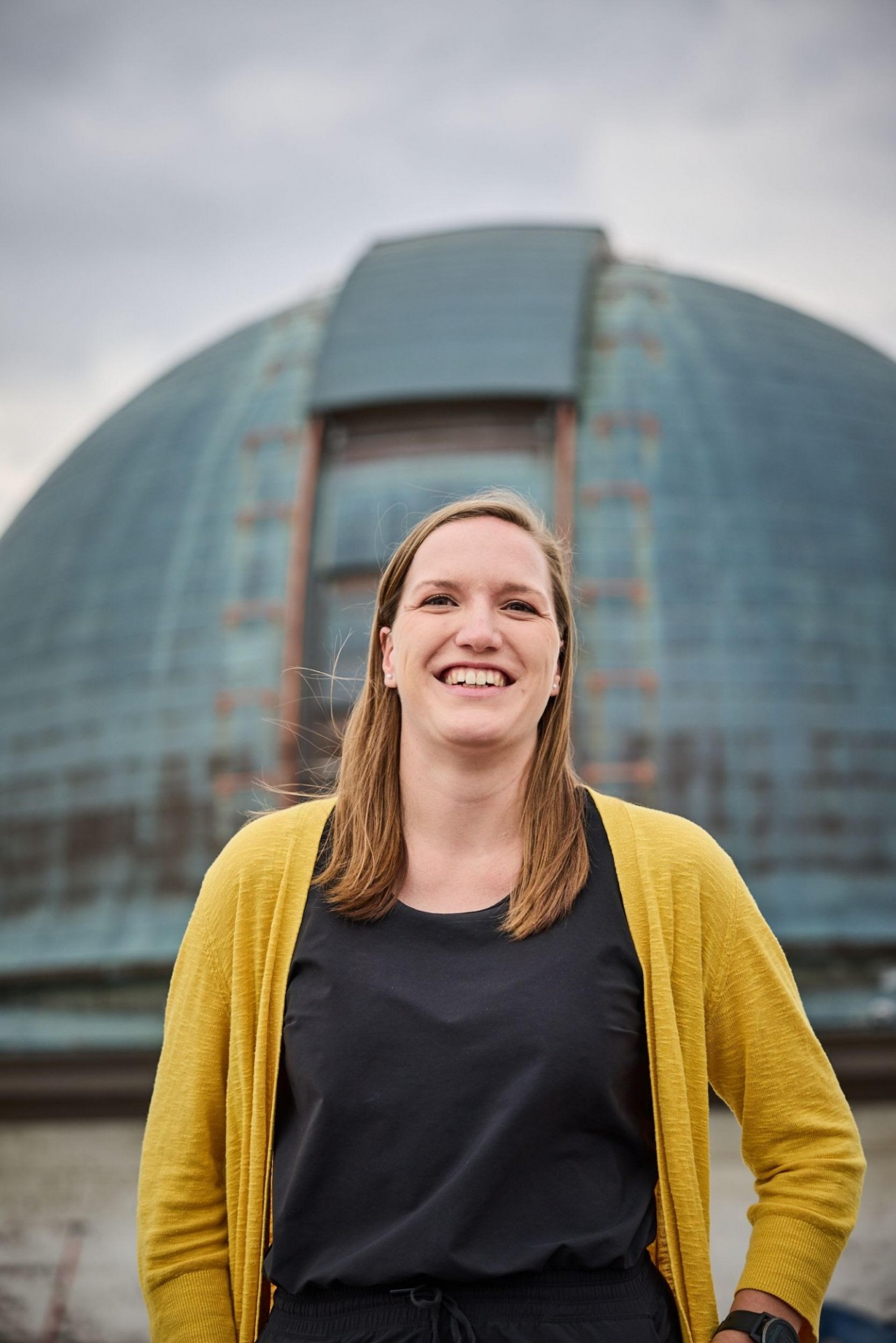
The second speaker of the session was Dr. Floor Broekgaarden, a Simons Society of Fellows Junior Fellow at Columbia University, with a talk titled “Gravitational Wave Paleontology: a New Frontier to Probe the Lives of Massive Binary Stars across Cosmic History.”
Massive stars are rare, and they die young – they’re the “rockstars” of the Universe, Dr. Broekgaarden says. Many of these massive stars live in binary systems too. When these massive stars die, a variety of things can happen, depending on their mass, but often they will explode in a supernova and will collapse into a black hole or a neutron star. While there are still many unknowns in binary star evolution, assuming both massive stars collapse into black holes, and the black holes stay in binary, it can be billions of years before these black holes collide with each other. It’s very difficult to observe black holes directly, but could observing merging binary black hole systems (BBH) allow us to learn about massive stars from billions of years ago? This question was the focus of Dr. Broekgaarden’s PhD thesis.
In her talk, Dr. Broekgaarden described four main hurdles in answering this question: 1. We don’t know how these binary black holes formed! Binary star system evolution is poorly understood – were the black holes an isolated pair that “grew old” together? Did one of the black holes come near another one and get dynamically (gravitationally) caught soon before merging? Was it something else? 2. There are uncertain initial conditions. For example, birth metallicities (the amount of non-Hydrogen elements when the star was first formed) can drastically alter the star’s evolution! These initial conditions really matter when simulating binary star evolution. 3. Gravitational Waves (GWs) are an extremely rare outcome among stars – the resulting black holes or neutron stars have to be sufficiently massive when they merge for us to see GWs from them. Using only this small sample of GW-detected mergers can introduce Poission noise (“small number statistics”) in analyses. 4. Binary stellar evolution is poorly understood. Similar to hurdle 1, we just don’t fully understand how these massive stars came to evolve into black holes.
In her PhD, Dr. Broekgaarden worked on hurdle 3 with her code “Stroopwaffle” where she used “Battleship” (the board game!) logic to help look for relations between various black hole parameters in the GW data. In working to address the other hurdles, Dr. Broekgaarden was able to quantitatively prove that uncertainties in both the stellar evolution and cosmic evolution history (black hole merger evolution) uncertainty have drastic impacts on the binary black hole merger rate.
Finally, Dr. Broekgaarden talked about her work in addressing the uncertainty in the life of the research scientist. In a Bulletin of the AAS (also co-published on Astobites!), Dr. Broekgaarden lists “10 ways to Improve Support Resources for Workplace Incivility in Astronomy.” After her postdoctoral fellowship at Columbia, Dr. Broekgaarden will be moving on to Johns Hopkins University as an Assistant Professor in July 2025.

The final speaker of the session was Dr. Justin Myles, a Brinson Fellow at Princeton University, with a talk titled “Combining Spectroscopic And Imaging Galaxy Surveys For Improved Measurements Of Large-Scale Structure.” Dr. Myles’ talk started with the famous painting, La Trahison des Images, set next to an image of a galaxy cluster, similarly titled “This is not a galaxy cluster.” This comparison was used to set the scene that images of galaxy clusters do not fully convey all that is needed to understand the complexities of galaxy clusters.
For example, it is known in galaxy clusters that there is a relation between the observed color (or the difference in magnitude of the same source between two filters, i.e. mag_g – mag_r) and the (assumed) redshift. Redshift can be measured in two main ways: photometrically (usually from filter drop outs and with high uncertainty) or spectroscopically (usually from emission lines and with low uncertainty), but because of the high uncertainty, it is often strongly preferred and even necessary to use the spectroscopic redshift (or “spec-z”). Measuring this color-redshift relation can be difficult because there is often incomplete spectroscopic data for the whole sample of clusters. A solution can be to develop new statistical methods to use this limited spec-z data!
While Dr. Myles’ work thesis work does not focus directly on this color-redshift relation, it does focus on using a combination of imaging and spectroscopic data as well as new statistical methods to learn more about galaxy clusters, all toward the goal of using them to learn more about the expansion of the universe. Two central works from his PhD were using hierarchical modeling (also sometimes known as forward modeling) combining the limited spec-z data with near infrared and optical imaging of galaxy clusters and the creation of the PITPZ (probability integral transformation [on] photo-z) algorithm. This algorithm helps to properly account for calibration uncertainty in reported photometric redshift estimations (which are sometimes reported as probability distributions). Dr. Myles’ work has important contributions to the study of galaxy clusters in the Legacy Survey of Space and Time (LSST) at the Vera Rubin Observatory.
One question Dr. Myles received at the end of his talk was on the prospects of obtaining observing time to measure the spectroscopic redshifts: telescope time is a limited resource and access to it is incredibly competitive. Dr. Myles said that he has some active proposals and sees opportunity with DESI. He also mentioned, though, given the incredibly competitive proposal process, that we might just have to wait for the first year of LSST to show insufficient results to get proposals approved.
The winner of the 2024 Cecilia Payne-Gaposchkin Doctoral Dissertation Award in Astrophysics will be announced at the DAP Business Meeting on Thursday evening.
The 4th Observing Run of the LIGO/Virgo/KAGRA Gravitational Wave Network (by Huei Sears)
The first speaker in this session was Elenna Capote from Syracuse University on behalf of the LIGO Collaboration with a talk titled “The Performance of the LIGO Detectors during the Fourth Observing Run.” In this, she covered some updates to the LIGO observatories and how these updates have improved their gravitational wave (GW) sensitivity. One of the most important updates to LIGO has been the installation of a new filter cavity which allows them to do “frequency-dependent squeezing.” Gravitational wave detector sensitivity is limited by quantum noise. At high frequencies (> ~80 Hz), this is shown as “shot noise” (or Poisson noise), while at low frequencies, this is shown as “radiation pressure” noise. This quantum noise results from the phase and amplitude of light, which is constrained by the Heisenburg uncertainty principle, where the change in phase times the change in amplitude must be greater than or equal to one. By “squeezing” the phase or amplitude, you can set which uncertainty you’d like to be lower. Frequency-dependent squeezing allows for the LIGO scientists to change which parameter they “squeeze” depending on which frequency they’re using – this helps to suppress both the shot noise at high frequencies and the “radiation pressure” noise at low frequencies! They also found that by using this squeezing method increased the binary neutron star (BNS) inspiral range (a measure of the sensitivity of the detector) by 15-18%!
Another big change to the LIGO observatories was changing the power the observatories were operating at. While it would be intuitive to think that more power is always better, they found through direct testing that LIGO Livingston Observatory (LLO) sees little sensitivity benefit with more power and that LIGO Hanford Observatory (LHO) had improved lock stability with less power! A “lock” is when the interferometer has light resonating through it under computer control – the observatory is “on” and “working,” so to speak. The LIGO scientists also found that decreasing the power at LHO increased the duty cycle significantly – it seemed that more power heated instrumental parts in an unexpected way and made things more unstable.
One question Elenna received at the end of her talk was what the next steps are to try and reach the intended design sensitivity for the LLO and LHO. She said that we’re almost there and we might be reaching thermal noise limits in some frequency ranges (though this will take robust analysis to be confirmed). LIGO scientists also want to better understand the unexplained nature of the high power instabilities.
The second talk of this session was led by Dr. Stefan Ballmer, also from Syracuse University, with a talk titled “Beyond O4: What lies ahead for Terrestrial Gravitational-Wave Detectors.” In his first few slides, Dr. Ballmer first reiterated some of Elenna’s updates – black hole mergers are observed almost daily, and the frequency-dependent squeezing update really improved LIGO’s sensitivity, but we’re nearing the limit of how deep LIGO can go. Improvements in GW astronomy with Terrestrial (Earth-based) observatories require the construction of a new, much larger facility. Dr. Ballmer talked about the A+ and A# upgrades to LIGO. They are hoping to install new, heavier test masses with better optical coatings, using a type of silica glass called Germania (GeO_2), which could achieve a ~30% thermal noise improvement.
For the remainder of his talk, Dr. Ballmer mostly presented on the “Cosmic Explorer” (CE) project. This observatory is similar to LIGO in that it is an interferometer and that there will be at least two sites. This observatory, however, is planned to be 10x larger than LIGO with one arm length at 40 km and the other at 20 km! With this increased arm length, common LIGO sources would be seen with a signal to noise ratio of 1000, and ALL short GRBs that had detectable associated GWs would be detectable. He noted that all upgrades to LIGO (both in A+ and the following A# [A-sharp]) will be applicable for Cosmic Explorer.
Cosmic Explorer is envisioned to be a NSF-funded project, and they’ve already received NSF funding to start designing the observatory. Right now, the big project underway is to find a site for the two detectors (in the way that Livingston, Louisiana and Hanford, Washington were chosen as the sites for LIGO). This is a choice with many inputs – prioritizing site topography (“flatness”) is good, but often these sites are in sedimentary basins (rocky) which act as seismic resonators. They also need to consider the local community by selecting a location where the indigenous community is supportive of the new facility – CE will disrupt the physical environment via the facility but will disrupt the cultural and financial environment too.
The final talk of the session (and of the day!) was from Penn State graduate student, Becca Ewing on behalf of the LIGO-Virgo-Kagra (LVK) Collaboration. In her talk, titled “Public Results in O4 from All-Sky Searches,” Becca offered an update on the O4a results. She started her talk with a question – “What are we looking for and why?” The answer – we’re mostly looking for “compact binary coalescences (CBCs)” which can be binary neutron star mergers, binary black hole mergers, and a mix of the two. We know what these look and “sound” like – the famous GW “chirp”, but we’re also looking for new, unmodeled things. These are called “bursts” and can include supernovae, magnetars, cosmic strings, among other exotic things. In O4a we were also able to study populations of gravitational wave signals – we detected 81 new GW candidates in O4a, nearly doubling the entire sample of GW events. In addition to these 81 highly significant signals, they release >1500 alerts for low significance events.
Becca went through a few of the superlative events from the subclass of the 81 events. Of the the 81, nearly all (~78) were classified to likely be Binary Black Holes, ~ 1-2 as NSBH, ~3-4 to be noise, and 0 to be BNS. None of the 81 events had any detected electromagnetic (EM) counterparts. While these EM counterparts (like a short GRB or a kilonova) are most expected for binary neutron star mergers, they could also (maybe!) be detected in a NSBH [and some extreme theories say BBHs too]. The ~1-2 NSBHs detected, however, had too poor localization for a robust EM search (however the new Rubin Observatory should be able to help with this in O5)! O4b is slated to start next week, and the VIRGO interferometer is set to be online. With an additional detector, the localizations will improve for these events, making EM searches more feasible. The last (and only) BNS was detected back in 2017 with GW170817 (Astrobite on this discovery here!) and luckily had an EM counterpart – a short GRB and a kilonova! It revolutionized many sects of astronomy, and a second BNS will similarly be a treasure of discovery.
Highlighting the research of Astrobites authors
We also want to highlight the research our Astrobites authors are doing and presenting at APS April!
Creative Ways to Outreach and Engage the Public (by Jessie Thwaites)
Astrobiter Storm Colloms gave a talk in this session, “Highlighting the humans behind the LIGO Collaboration.” The talk focuses on the question: How can we make people feel that science (specifically, gravitational wave science) is for them? One of the ways that they do this is through the LIGO magazine, published twice yearly by the LIGO collaboration. It centers personal perspectives from people at all career levels in LIGO, from high school students to faculty. As the collaboration has grown, so has the number of countries and institutions included in each issue.
A second LIGO initiative is the Humans of LIGO blog, which centers experiences of collaboration members through blog posts. Each blog post includes personal stories or answers to an interview, with a short bio about the person. Highlighting different scientists is important to show a realistic cross section of the people working on the experiment, to encourage people from diverse backgrounds to continue pursuing their scientific interests.
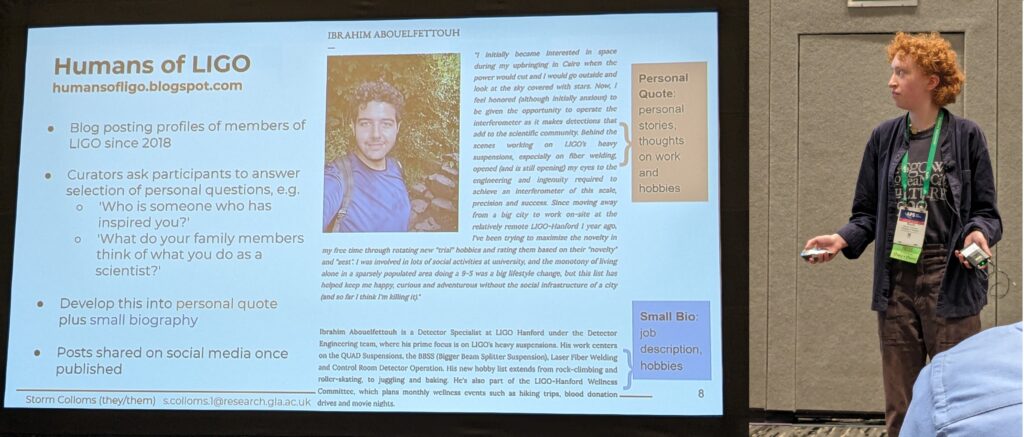
Observing GW Sources (by Storm Colloms)
One of the last sessions of the day was short contributed talks on observing gravitational wave (GW) sources – how we can find evidence for black holes, neutron stars, and more, in data from gravitational wave observatories and from other messengers. In this session, Astrobites writer Jessie Thwaites spoke about the search for neutrinos in combination with GWs, using the IceCube neutrino observatory located in the south pole. By tracing the direction of high energy neutrinos through the Antarctic ice, the origin of the neutrinos on the sky can be located ~500 times more precisely than with current detections of GWs. If there’s evidence for the neutrinos coming from the same source as GWs, we can pinpoint the location of the source of the radiation and particles, and better learn the source’s origin and astrophysical properties.
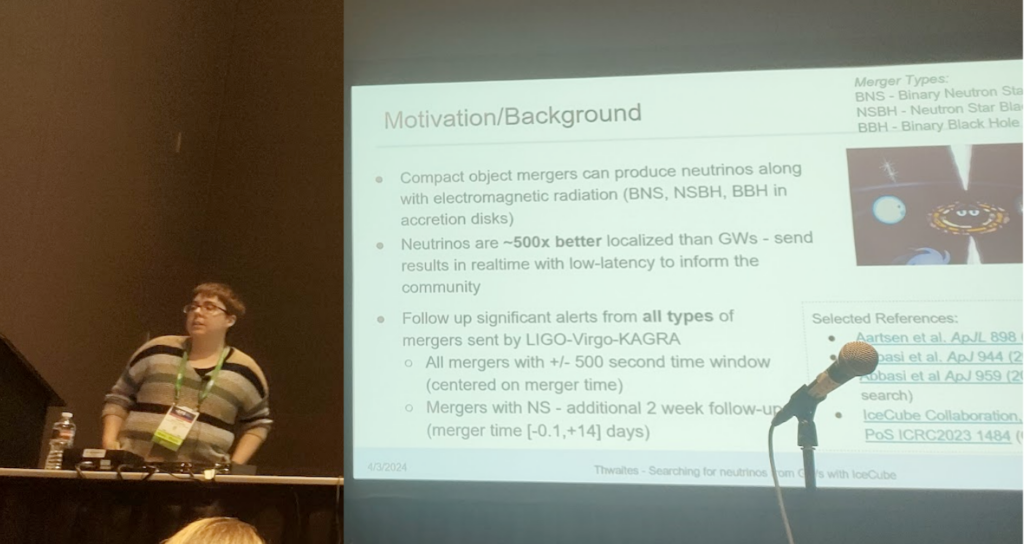
Jessie summarized the search for significant neutrino candidates during the ongoing LVK GW observing run (O4), where the real-time alerts from IceCube were sent out on average 21 minutes after each GW event, in contrast to 56 minutes in the previous observing run (O3) which ended in 2020. While four binary neutron star merger alerts from this observing run were later retracted from being astrophysical events, Jessie showed binary black hole mergers from O4 that coincided with neutrino observations. Meanwhile, we keenly await the start of the second half of O4, which will see the GW detectors be observing again from April 10th, and hope the universe is kind enough to grant us some cool (as cool as neutrinos zooming through ice) multi-messenger astronomy!
Featured Image Credit: NASA, ESA, CSA/Joseph DePasquale (STScI), Anton M. Koekemoer (STScI)
Edited by: Storm Colloms, Huei Sears, Jessie Thwaites

